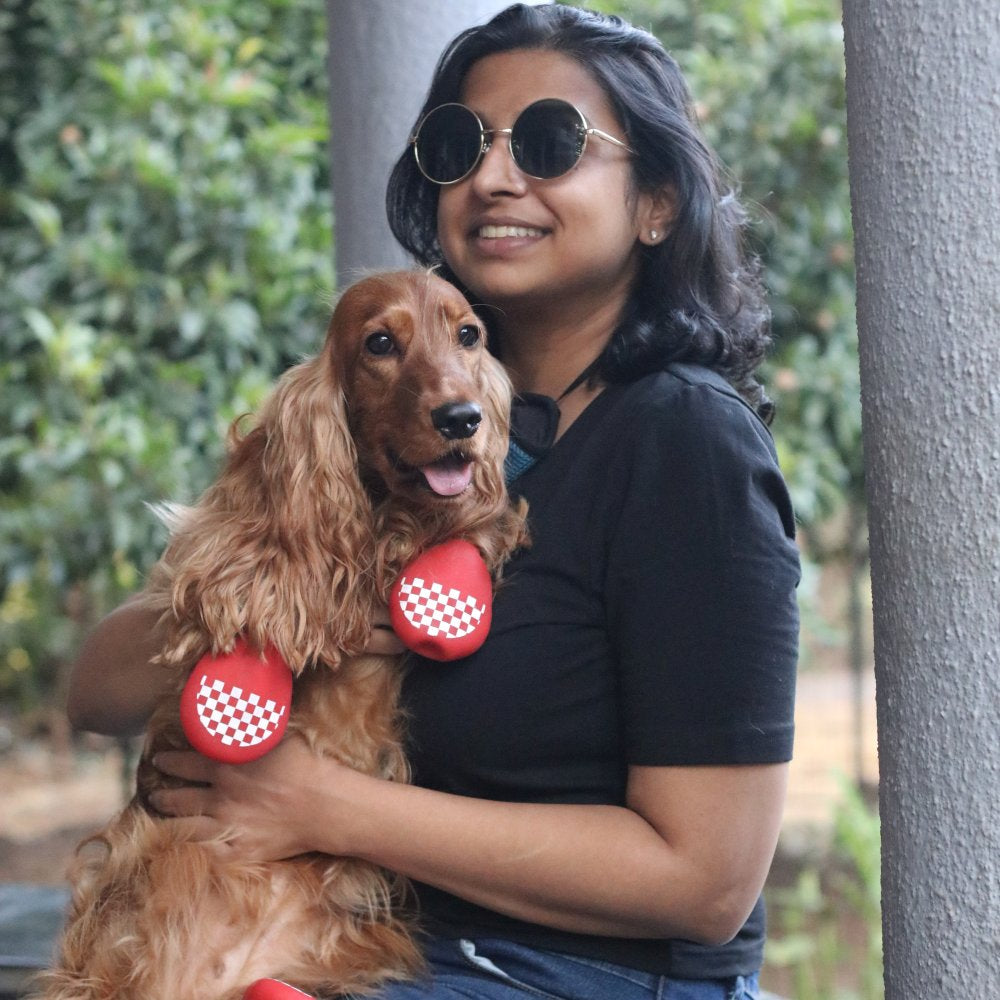Hip Dysplasia In Dogs: DOs & DON'Ts Pet Parents Must Follow

Nothing scares us more than seeing our fur babies struggling with their health. Dealing with injuries and diseases can take a toll on our dog’s and our lives. But, at times like these the bond we have with our dogs is tested. When we, as pet parents, need to hold it together and do our best to console and love our pawfect darlings back to health.
Hip Dysplasia is a condition where the ball and socket of the hip joint either do not fit due to heredity or they do not develop properly because of genetic, environmental or arthritic conditions. This causes the hip to rub and scrape leading to eventual joint degradation.
Not sure if your dog has early signs of Hip Dysplasia? Take this quiz to find out!
Hip Dysplasia can be painful and your usually energetic dog may lose their playful will. What can you as their best friend do to cheer them up during this difficult time?
Following are Dos and Don'ts with which you can ease your dog's pain-
DOs:
1) A Healthy Diet for a Healthy Life:Overeating will result in obesity and obesity will put more pressure on their limbs. This strain will in turn worsen their joint condition.
Nonetheless, it is extremely important that they receive an adequate, healthy diet that will give them the strength to recover.
-
Feed them fresh food : cooked and raw meat, chicken(for iron), green leafy vegetables like spinach (Vitamin C), and bones(for minerals and nutrition).
-
Dairy products like milk, yogurt, etc. (for calcium) should be consumed in small doses only.
-
Tuna and Salmon are great sources of omega-3 fatty acids. This will improve your dog's immune system, coat, and keep their skin healthy.
Consult your vet or dog nutritionist and come up with a customized diet plan that suits your dog’s needs lest they do not fall deficient in any form!
As a result of hip dysplasia, your usually jumpy dog may not find it in themselves to move much. But it is essential that they get their daily exercise done. Do not overwork them. Find out the perfect exercise plan for your dog by taking their breed, body, weight, and condition into consideration.
Exercises to do?
-
Start with a short,15-20 mins slow walk in their favorite park.
-
Consider low impact, muscle-building exercises, and stretches like sit to stand to heel and repeat. You can check this video for demonstration
-
Take them swimming! The water buoyancy supports the muscles surrounding the hip joint. It also loosens tight ligaments, relieving their pain.

There is nothing better than a long, warm bath after a stressful day, right? The same applies to your dog. Give them a warm bath once a week. You can also add Epsom salt to the water as that will help them relax.
Another thing you can do is gently massage their hip in a circular motion with your fingertips. Watch this video to find out how to give a relaxing massage to your dog.
A great relaxing activity is to let them sunbathe during chilly winters. 
Let their living space be a sanctuary to them! One where they can easily move around wagging their tails. If your place has tile flooring which is quite typical in Indian households, you might consider changing them to slate or granite flooring. Carpeting or putting rugs is also an option.
Get them anti-slip indoor shoes. These provide traction and prevent them from skidding. Ensure that they are comfortable and breathable to your dog’s liking. Zoof Grips are specifically designed for dogs who have Canine Hip Dysplasia.
See to it that they don’t slip or hurt themselves. Avoid staircases and use ramps at all times possible. Basically, no jumping business around the house!
Make special arrangements for their sleeping area. Consider getting an orthopedic memory foam bed to support your pooch’s bone health.
Hip and joint supplements including glucosamine chondroitin sulfate, MSM, and fish oils help your dog by reducing inflammation and pain. They foster cartilage and other soft tissues and increase joint lubrication.
You can also give them herbs like dandelion, nettle, alfalfa, rosemary, ginger, etc. These herbs are filled with minerals and vitamins that improve metabolism, blood circulation and help in joint rehabilitation. They can do wonders for your dog’s comprehensive health.
You should always consult your Vet before giving your dog any kind of supplements. Learn about the product and dosage that suits your dog’s medical condition and needs.
We don’t even need to mention this because the good parent you are, your baby must already be pampered with care. Nevertheless, it can get extremely tedious trying to always accompany your fur baby when they need to take the stairs or are facing physical problems because of hip dysplasia. Be patient and try not to stress too much.

Let’s dive into the Don’ts that pet parents must follow
DON’Ts:
1) Overfeeding:Overfeeding your dog is never a good idea. Yes, even when they hungrily ask you for treats with those puppy eyes! But it is especially forbidden if they have hip dysplasia. 
Exercising is the best activity to keep your dog's body active and healthy. Anything done excessively loses its charm, and same goes for exercising your dog. Hip Dysplasia is a painful condition, hence overdoing it might not be in your dog’s favor.
What to avoid?-
Avoid cracked pavements, rocky structures, etc. that may make your dog stumble.
-
Jumping, High-Intensity exercises, etc. are a No-No.
- Do not overwork them. They should be having fun and not working more than they can take. Over-exercising can have an adverse effect on their hip health.

Keep them away from damp and chilly weather as that can aggravate the pain. To do this, you must dress them up in chic but super comfortable sweaters, coats, etc. Tuck them in warmly by adding extra bedding to their napping place!
Heating Pads are good too. Don’t let them overheat though as that can have adverse effects. Instead, wrap the heating pack in a cloth and then let your dog take aid in them.
Dogs often hide their pain, so it's important to watch for signs like less activity or changes in eating habits. It is crucial for pet owners to pay close attention to subtle changes in behavior, such as decreased activity, skidding, limping, difficulty in getting up or changes in appetite, as these could be signs of underlying pain or discomfort. Regular vet check-ups and knowing your dog's normal behavior can help catch any health problems early.
Fun Fact: It's observed that male dogs are more vocal about their pain, than female dogs.(Let us know in the comments section if you relate to it or if you have your own Dog story.)
Bonus Points:

-
Acupuncture- The magic touch:
Acupuncture is a tried and tested way that lets your dog relax. It achieves this by touching the points that connect with the peripheral nerve pathways of their body. It helps reduce pain and assists them to get back that balance. Make sure that your acupuncturist is a DVM and certified.
Even though acupuncture can’t fix the fact that a dog with hip dysplasia has a malformed hip socket; it eases a lot of aches by relaxing the muscle tension that has accumulated through chronic compensation of this loose joint.
Consult with your dog’s primary vet to determine whether acupuncture is a good idea for your dog. They may also recommend a good local veterinary acupuncturist. Dr. Akshay Shah (Acuvet) is a preeminent name in Mumbai. Check out our exclusive interview blog with him where he answers all your frequently asked questions about hip dysplasia.
-
Hydrotherapy- To wash away the pain
Aquatherapy is another great option that you can try; particularly if your dog enjoys playing in the water. Even if they are afraid or don't like water much, you can consider hydrotherapy where they know how to help reluctant dogs.
Hydrotherapy consists of underwater treadmill or swimming pool exercises. You can get a plastic pool from the store too.
You’re wondering why it works? The thing is, exercising in water reduces the pressure on your dog’s rear limbs due to water’s buoyancy. Thus, making it fun, advantageous, and less painful all at the same time.

-
Look into surgery options
Not all dogs are good candidates for surgery. But if your dog is struggling excessively then talk to your vet and consider your options. While undergoing a Canine Hip Dysplasia Surgery can be expensive; it is substantial if your dog is severely affected. Some of the primary surgical options include-
-
Double or triple pelvic osteotomy (DPO/TPO)
-
Total hip replacement (THR)
-
Femoral head osteotomy (FHO)
-
Juvenile pubic Symphysiodesis and Hip denervation are other surgical strategies that may be worth your attention.
Conclusion:
Dogs can feel when their 'hoomans' aren't feeling good. So, surround yourself with positive vibes. A smile on your face will result in a smile on your dog’s face. Stay strong! Your efforts will bear fruit. Your dog will be back to being “the happy, happy dog, just a happy, happy, happy dog” in no time.




Leave a comment